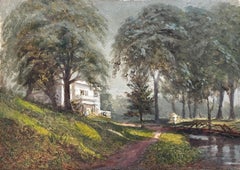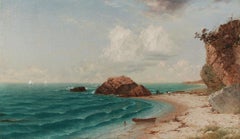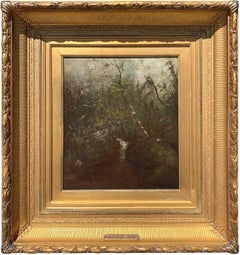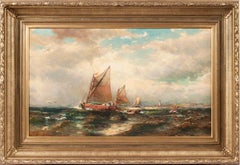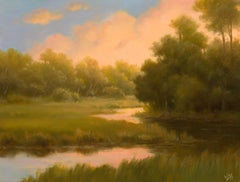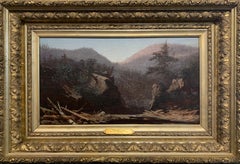John Frederick Kensett Art
to
1
7
5
5
2
5
1
1
Overall Height
to
Overall Width
to
2
2
2
1
1
1
1
1
1
1
1
1
1
1
1
1
1
1
1
1
7
7
6,934
3,277
2,514
1,215
7
6
3
3
2
Artist: John Frederick Kensett
"White House and Trees, " John Frederick Kensett, Hudson River School, New Jersey
By John Frederick Kensett
Located in New York, NY
John Frederick Kensett
White House and Trees, circa 1853
Oil and gouache on paper
6 3/4 x 9 3/4 inches
Provenance:
Estate of Vincent Colyer (1824 - 1888)
By descent
Paul Magriel Collection
Private Collection, Long Island
Exhibited:
New York, The Finch College Museum of Art; Southampton, New York, The Parrish Art Museum; New Orleans, Louisiana, Isaac Delgado Museum of Art; Norfolk, Virginia, Norfolk Museum of Art; Montclair, New Jersey, Montclair Art Museum; New London, Connecticut, Lyman Allyn Museum; Manchester, New Hampshire, The Currier Gallery of Art; Providence, Rhode Island, Rhode Island School of Design; Youngstown, Ohio, The Butler Institute of American Art, American Drawings (Benjamin West to the present) from the Paul Magriel Collection, June 1961 - December 1962.
Portland, Oregon, Portland Art Museum, April 14 - May 15, 1963.
Boston International Fine Art Show at the Cyclorama, Lincoln Glenn, October 19 - 23, 2022.
In the 1850s through 1860, John Frederick Kensett, painted a series of at least five landscapes of the "Shrewsbury River" (now the Navesink River) along the New Jersey shore. Art historians have described Kensett’s paintings of the river as having evolved from a trip in the fall of 1853 at the invitation of Kensett's friend, author and lecturer George Curtis. However, letters viewable at the Smithsonian Archives of American Art website make it clear that Kensett had become acquainted with the area over a year earlier, most likely in connection with fellow artist and friend Thomas Prichard Rossiter.
Kensett and Rossiter had been friends since at least the 1830s. As aspiring artists, they had traveled to Europe together in the 1840s. In 1851 Rossiter married Anna Ehrick Parmly, then in her early 20s, and Kensett attended the wedding. Anna was one of four daughters of Eleazer and Anna Maria Parmly. Eleazer, one of the major figures in American dentistry history, was a wealthy and accomplished member of New York society.
When not in the city, the Parmly family gathered at Bingham Place, a sprawling estate on 275 pastoral acres spanning the peninsula between the Shrewsbury and Navesink Rivers along the New Jersey shore. The Bingham Place estate encompassed much of what is now Rumson, then known as Oceanic, N.J. It was a wide-open landscape of ocean views, orchards, lawns, and cattle-dotted pastures. There the Parmlys opened their doors to family, friends, and the summer breeze.
Rossiter, newly-married into the Parmly family, was likely the reason that Kensett paid a social visit to Bingham Place in the summer of 1852. On July 11, 1852, having reluctantly departed, Kensett wrote Rossiter who was still at Bingham Place:
New York to me now is that of a deserted place…marking a dismal contrast to the green lawns at Bingham Place. I saw the receding shores of Shrewsbury & the line of dust which marked your homeward course & finally the last glimpse of the Locust trees that shade the pleasant mansion & happy inmates at Bingham with any thing but a joyous spirit.
A major figure in the American luminist tradition and one of the most renowned painters of the Civil War era, John Frederick Kensett was born in Cheshire, Connecticut, in 1816. He was the son of Thomas Kensett, a British immigrant engraver, and it was in his father's New Haven firm that Kensett first learned to draw.
After mastering the rudiments of the graphic arts, he worked as an engraver in print shops in New Haven, Albany, and New York throughout the 1830's. During this period, he began to paint on his own, encouraged by a friend and fellow artist, John W. Casilear. In 1838, he made his first submission, a landscape, to the annual exhibitions of the National Academy of Design.
Desirous of continuing his training, Kensett traveled to Europe in 1840. For the next seven years, often in the company of artists such as Casilear and Asher B...
Category
1850s Hudson River School John Frederick Kensett Art
Materials
Paper, Oil
New England Coastal Scene with Figures
By John Frederick Kensett
Located in New York, NY
Monogramed and dated lower right: JF.K. / ‘64.
Category
Mid-19th Century Hudson River School John Frederick Kensett Art
Materials
Canvas, Oil
Woodland Waterfall by John Frederick Kensett (American: 1816-1872)
By John Frederick Kensett
Located in New York, NY
JOHN FREDERICK KENSETT (1816-1872)
Woodland Waterfall
Oil on canvas
14 x 12 inches
Signed lower right
Category
19th Century Hudson River School John Frederick Kensett Art
Materials
Canvas, Oil
"Portrait of an Italian Fencer, " John Frederick Kensett, Hudson River School
By John Frederick Kensett
Located in New York, NY
John Frederick Kensett (1816 - 1872)
Portrait of an Italian Fencer, circa 1845-47
Watercolor on wove paper
13 1/8 x 8 1/8 inches
Signed with initials and inscribed lower right "J.F.K. Rome"
From October 1845 through the spring of 1847, Kensett lived in Rome. He attended classes where he sketched from live models, and he sketched in the countryside outside Rome and around Florence, Perugia, and Venice, places he visited with his artist friends. He fulfilled commissions for paintings from Americans in Italy, and by 1847 his career was well established.
Son of an English immigrant engraver, John Kensett lacked enthusiasm for that medium and became one of the most accomplished painters of the second generation of Hudson River School painters. His reputation is for Luminism, careful depiction of light, weather, and atmosphere as they affect color and texture of natural forms. He was particularly influenced by the painting of Asher Durand in that he focused on realism and detail rather than the highly dramatic views associated with Thomas Cole. Going to the western United States in the mid 1850s and the 1860s, he was the first of the Hudson River School painters to explore and paint the West.
Kensett was born and raised in Cheshire, Connecticut, and learned his engraving from his father, Thomas Kensett with whom he worked in New Haven, Connecticut until 1829. He continued working until 1840 as an engraver of labels, banknotes and maps and was employed part of that time by the American Bank Note Company in New York City. There he met Thomas Rossiter, John Casilear, and other artists who urged him to pursue painting. In 1840, he and Rossiter, Asher Durand, and Casilear went to Europe where Kensett stayed for seven years and supported himself by doing engraving but became accomplished in landscape painting.
Having sent canvases of Italian landscapes back to New York, he had a reputation for skillful painting that preceded him. When he returned to New York City in 1847, he was an "instant success" and very sought after by collectors. Two of his Italian landscapes had already been purchased by the American Art Union. By 1849, he was a full member of the National Academy of Design and was generally popular among his peers. His studio was a gathering place with travelers stopping by to see his canvases and to identify "precise locations in the Catskills or Newport or New England in the oil sketches and drawings that covered his walls." (Zellman 170). For the women, he was a popular bachelor, "romantic looking with high forehead and sensitive expression." (Samuels 262)
He was also sought after by many organizations. Among his activities were serving on the committee to oversee the decoration of the United States Capitol in Washington DC, and becoming one of the founders of the Metropolitan Museum in New York.
An inveterate traveler, Kensett spent summers on painting excursions away from New York City. One of these trips was a special painting excursion with fifteen other artists sponsored by the B & O Railroad from Baltimore, Maryland to Wheeling, West Virginia. Unlike many of the Hudson River painters...
Category
1840s Hudson River School John Frederick Kensett Art
Materials
Watercolor, Paper
Beacon Rock, Newport
By John Frederick Kensett
Located in New York, NY
Monogrammed and dated lower right: JF. K. 63
Category
19th Century Hudson River School John Frederick Kensett Art
Materials
Oil
Mount Chocorua
By John Frederick Kensett
Located in New York, NY
Leading Hudson River School Painter Famous for New England Views.
Category
19th Century Hudson River School John Frederick Kensett Art
Materials
Oil
At Pasture
By John Frederick Kensett
Located in New York, NY
Leading Hudson River School Painter Famous for New England Views
Category
19th Century Hudson River School John Frederick Kensett Art
Materials
Oil, Canvas
Related Items
Seascape by George Herbert McCord (American, 1848-1909)
By George Herbert McCord
Located in New York, NY
"Seascape," by Hudson River School artist George Herbert McCord (1848-1909) is oil on canvas and measures 18.07 x 30.13 inches. The work which comes from a private collection in Birmingham, Alabama is signed “G.H. McCord A.N.A.” at the lower left. The work is framed in a beautiful, period appropriate frame, and ready to hang.
A member of the second generation of Hudson River School painters, George Herbert McCord is known for his atmospheric landscape and marine paintings which capture a variety of locales and are executed in a variety of media—including oil, pastel, and watercolor. McCord was born in 1848 in New York City, where he lived and worked his entire life. After
1883, he kept an additional studio in Morristown, NJ. McCord traveled throughout North America, painting in the Berkshire, Adirondack and Laurentian mountain ranges, the Hudson River Valley, the Coast of New England, the Upper Mississippi, and Florida, which had become popular among Eastern vacationers. He was among a select group of artists commissioned by the Santa Fe Railroad to paint the Grand Canyon, and also participated in a special painting excursion to the Erie Canal. His travels in Europe were equally expansive, taking him to England, Scotland (having been commissioned by Andrew Carnegie to paint the scenery around his castle there), France, the Netherlands, and Italy.
McCord was well-educated, having attended Claverack College amidst the Catskills in Claverack, NY, which provided instruction in classical, French, German, English, music, painting, military, commercial, telegraphic and agricultural studies. He also studied with the accomplished painter and inventor of Morse code, Samuel F.B. Morse, and with the Scottishborn
landscape painter, James Fairman.
McCord was active in numerous art clubs and institutions in New York, including the National Academy of Design, which elected him an Associate member in 1880, the American Watercolor Society, the Brooklyn Art...
Category
19th Century Hudson River School John Frederick Kensett Art
Materials
Oil, Canvas
Marsh and Meadows
By Jane Bloodgood-Abrams
Located in San Francisco, CA
Oil on panel
Signed and titled on verso.
Category
2010s Hudson River School John Frederick Kensett Art
Materials
Oil
Romantic American School Fall Forest Interior Impressionist Framed Oil Painting
Located in Buffalo, NY
Antique American impressionist fall forest oil painting. Oil on canvasboard. Finely painted and housed in a period giltwood frame.
Category
1890s Hudson River School John Frederick Kensett Art
Materials
Canvas, Oil
H 23 in W 17 in D 2 in
Richard Caton Woodville II (1856 - 1927) 1794 War Balloon Aquarell England 1910
By Richard Caton Woodville Jr.
Located in Meinisberg, CH
Richard Caton Woodville II
(British, 1856 - 1927)
The French Aerostatic Corps - The first War Balloon The launching of the L'Entreprenant used by the French Army under General Jourd...
Category
1910s English School John Frederick Kensett Art
Materials
Paper, Watercolor, Gouache, Cardboard
Free Shipping
H 15.56 in W 22.25 in D 1.58 in
Hudson River School Style Painting, c. 1900
Located in Larchmont, NY
Untitled, c. 1900
Oil on canvas
16 x 24 in.
Framed: 22 3/4 x 31 x 2 in.
Signed lower right
Category
Early 1900s Hudson River School John Frederick Kensett Art
Materials
Canvas, Oil
Delaware Gap
By Régis François Gignoux
Located in Milford, NH
A finely detailed oil landscape of the Delaware Gap attributed to French American artist Regis Francois Gignoux (1816-1882). Gignoux was born in Lyon, France, and began his studies i...
Category
Mid-19th Century Hudson River School John Frederick Kensett Art
Materials
Canvas, Oil
In Toadstools - Contemporary Figurative Ink, Watercolor Painting, New Expression
Located in Salzburg, AT
The artwork is in plain Ikea frame behind plexi
Unframed size: 36x48 cm, Framed 42.5x52.5 cm
Grażyna Rigall is a painter, illustrator, author of stage designs and music videos. - Th...
Category
2010s Contemporary John Frederick Kensett Art
Materials
Paper, Ink, Watercolor
Surrealist Gouache and Watercolour on Paper, 'Sunday School Ghosts'.
Located in Cotignac, FR
Surrealist watercolour and gouache on handmade paper by British artist Derek Carruthers. Signed bottom right and signed, dated and titled 'Sunday School Ghosts' to the reverse.
A wo...
Category
21st Century and Contemporary Surrealist John Frederick Kensett Art
Materials
Acrylic, Handmade Paper, Watercolor, Gouache
H 22.45 in W 29.93 in D 0.08 in
Lake Placid, Whiteface Mountain
Located in Saratoga Springs, NY
Monogram lower right.
But for sheer numbers, as well as degree of fame, the activity which is most closely linked with this Adirondack town is painting. Mrs. Peggy O'Brien, who has long studied Adirondack artists, finds over 400 have painted in these mountains and Keene Valley was the summer capital for many of them. The earliest in the valley are Asher B. Durand (1796-1800), considered a co-founder of the Hudson River School, John Casilear (1811 -1893) and John F. Kensett (1816 - 1871) coming in 1848.
Frederick Perkins came in 1857, boarded at the Bruce home, and with Orson Phelps sat on Mt. Marcy and named Skylight, Basin and Saddelback Mountains. Roswell Shurtleff came first to Keene Valley in 1868 and returned each year for the rest of his life, being, with A.H. Wyant, the first artists to have summer places here. Wyant built on the hillside east of the AuSable, Shurtleff on the west. Winslow Homer joined John Fitch and Shurtleff in Keene Valley for hunting, fishing, and painting.
John Adams Parker was here by 1866, subsequently building. Robert Monior came in 1875 and by 1882 had a house that became a center for art students. Samuel Coleman arrived in the 1860's. Homer Martin (1836-1897), Sanford Gifford (1823-1880), and Arthur Parton (1842-1914) are but a few more of the recognized American artists who painted the AuSable lakes and mountain of Keene in the nineteenth century. In fact, the Heidelberg Museum of the Paletinate's salute to the American Bicentennial was a 1976 exhibit of work by the first German to the American scenes, a man named Kappel, and featured scenes around Beede's.
John Marin brought Keene Valley art into the twentieth century. Harold Weston, son of S. Burns Weston, wintered alone at his AuSable Club studio 1920-21 to start his painting career, and gave us later life a good local history as well as art sampling in his autobiography Freedom in the Wilds (1971). Present day artists living or working in the town include Bruce Mitchell...
Category
Late 19th Century Hudson River School John Frederick Kensett Art
Materials
Oil, Board
Lake Mohonk by Hudson River Artist Nelson Augustus Moore (American, 1824-1902)
By Nelson Augustus Moore
Located in New York, NY
A rare depiction of Lake Mohonk, this painting by Hudson River School artist Nelson Augustus Moore (1824-1902) features Sky Top Tower and the serene natural surroundings of the historic Mohonk Mountain House. This 19th century oil painting on canvas measures 12 x 17.75 inches. The painting is signed and dated at the lower right, signed again and titled "Lake Mohonk" on the verso. The painting is framed is ready to hang.
Nelson Augustus Moore was born on August 2, 1824, in Kensington, CT. His artistic studies began under the tutelage of Thomas Cummings and Daniel Huntington in New York City. After returning home to Connecticut, Moore taught drawing classes and also opened a photography business. He and his brother operated this daguerreotype studio in Hartford, CT until 1864 when Moore chose to return to landscape painting. His landscapes consisted mostly of New England
subjects. He kept a studio in New York, painting in the same building as Arthur Fitzwilliam Tait, James Hart and William Hart.
Nelson Augustus Moore, while sharing in many ideologies with his contemporaries, felt no need to travel vast distances in search of grandiose and spectacular landscapes. He held a particular delight in the peaceful harmony of the local American countryside...
Category
19th Century Hudson River School John Frederick Kensett Art
Materials
Canvas, Oil
Hudson River Inlet, 1885 by American artist Frank Anderson (American: 1844-1891)
By Frank Anderson
Located in New York, NY
Hudson River Inlet, 1885 by Hudson River School artist Frank Anderson (1844-1891) is oil on canvas. The work measures 15.13 x 24.25 inches ...
Category
19th Century Hudson River School John Frederick Kensett Art
Materials
Canvas, Oil
Landscape in the Hudson Valley by Worthington Whittredge (American, 1820-1910)
By Worthington Whittredge
Located in New York, NY
Hudson River School artist Worthington Whittredge's (1820-1910) Landscape in the Hudson Valley is oil on canvas and measures 11 x 19 inches. The work is signed by the artist at the l...
Category
19th Century Hudson River School John Frederick Kensett Art
Materials
Canvas, Oil
Previously Available Items
Kaaterskill Falls, New York, Hudson River School Landscape, Signed and Framed
By John Frederick Kensett
Located in Doylestown, PA
"Kaaterskill Falls" is a 9" x 16" oil on canvas landscape by Hudson River School and luminist painter John Frederick Kensett. The painting is framed and monogrammed in the lower left...
Category
Mid-19th Century Hudson River School John Frederick Kensett Art
Materials
Canvas, Oil
John Frederick Kensett art for sale on 1stDibs.
Find a wide variety of authentic John Frederick Kensett art available for sale on 1stDibs. You can also browse by medium to find art by John Frederick Kensett in paint, oil paint, canvas and more. Not every interior allows for large John Frederick Kensett art, so small editions measuring 10 inches across are available. Customers who are interested in this artist might also find the work of Jasper Francis Cropsey, William Bradford, and William Rickarby Miller. John Frederick Kensett art prices can differ depending upon medium, time period and other attributes. On 1stDibs, the price for these items starts at $10,000 and tops out at $450,000, while the average work can sell for $87,500.
